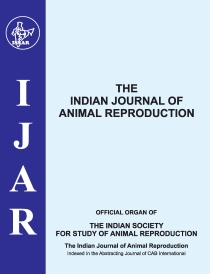Ultrasonography assisted estrus detection improves the submission rate in prostaglandin treated sub-estrus Murrah buffaloes
DOI:
https://doi.org/10.48165/ijar.2023.44.01.9Keywords:
Sub-estrus, Buffalo, Ultrasonography, Estrus induction, Prostaglandin, Preovulatory follicle sizeAbstract
Sub-estrus is a condition in buffalo in which the ovarian picture and uterine changes suggest the presence of estrus and cyclicity, despite the absence of behavioural symptoms. The current study describes the effects of ultrasonography (USG)-aided estrus detection on submission and conception rate in sub-estrus Murrah buffaloes after a single shot of prostaglandin (PG) treatment. The study included 67 sub-estrus buffaloes between 2020 and 2021. The teaser bull was used to detect estrus, and the diameter of the pre-ovulatory follicle (POF) and corpus luteum (CL) was measured using transrectal USG. A single PG treatment induced behavioural estrus in 43.28% buffaloes (Gr. 1), while estrus were detected in 35.8% of sub-estrus buffaloes using sonographic examination (Gr. 2) that were otherwise remained undetected. The overall submission rate was 79.1 percent. The first-service conception rate was higher in Gr. 1 (55.2 vs. 33.3%), compared to Gr. 2. The CL diameter at pre-treatment was significantly larger in Gr. 1 buffaloes than in Gr.2 buffaloes. However, the POF diameter was comparable during induced estrus. Furthermore, the time elapsed between induction and breeding in both groups was comparable. Furthermore, the CL size at pre-treatment, POF size at estrus, and time elapsed to breeding had no effect on conception. Thus, the use of USG improves the submission rate in PG administered sub-estrus buffaloes, resulting in a 45.3% overall first service conception rate. However, breeding time must be optimised in order to improve the conception rate and efficient reproductive management in sub-estrus buffaloes in the field.
References
Agarwal, S.K. and Shankar, U. (1994). Annual Report, Livestock Production Research (Cattle and Buffalo). Published by Indian Veterinary Research Institute, Izatnagar, U.P., India.
Awasthi, M. K., Kavani, F. S., Siddiquee, G. M., Sarvaiya, N. P. and Derashri, H. J. (2007). Is slow follicular growth the cause of silent estrus in water buffaloes? Anim. Reprod. Sci., 99:258-268.
Baruselli, P.S. (2001). Control of follicular development applied to reproduction biotechnologies in buffalo. In: Proc. I Congresso Nazionale sull’Allevamentodel Bufalo, Eboli (SA), Italy.pp.128–146.
Basic Animal Husbandry Statistics. (2022). Published by Department of Animal Husbandry and Dairying, Ministry of Fisheries, Animal Husbandry & Dairying. Government of India.
Brito, L.F.C., Satrapa, R., Marson, E.P., Kastelic, J.P. (2002). Efficacy of PGF2α to synchronize estrus in water buffalo cows (Bubalus bubalis) is dependent upon plasma progester one concentration, corpus luteum size and ovarian follicular status before treatment. Anim. Reprod. Sci., 73(1-2): 23-35.
Day, M.L., Geary, T.W. (2005). Handbook of estrus synchro nization. Western Assoc Experiment Station Directors, WRP014:2-39.
De Araujo Berber, R.C., Madureira, E.H., Baruselli, P.S. (2002). Comparison of two Ovsynch protocols (GnRH versus LH) for fixed timed insemination in buffalo (Bubalus buba lis). Theriogenology, 57(5): 1421-1430.
De Rensis, F. and López-Gatius, F. (2007). Protocols for synchro nizing estrus and ovulation in buffalo (Bubalus bubalis): A review. Theriogenology, 67(2): 209-216.
Dhaliwal, G.S., Sharma, R.D., Singh, G. (1988). Efficacy of pros taglandin F2α administration for inducing estrus in buffalo. Theriogenology, 28:1401–06.
Honparkhe, M., Singh, J., Dadarwal, D., Dhaliwal, G.S. and Kumar, A. (2008).Estrus induction and fertility rates in response to exogenous hormonal administration in post partum anestrus and sub-estrus bovines and buffaloes. J. Vet. Med. Sci., 70(12): 1327–1331.
Kumaresan, A., Ansari, M.R., Sanwal, P.C. (2001). Assessment of accuracy of oestrus detection by progesterone assay in cattle and buffaloes. Indian J. Anim. Sci., 71(8): 758-760.
Markandeya, N.M., Bharkad, G.P. (2002). Effect of cloprostenol on conception rate during spring in sub-oestrus Murrah buffaloes. Indian Vet. J., 79:1205-1206.
Mishra, G.K., Patra, M.K., Sheikh, P.A., Teeli, A.S., Kharayat, N.S., Karikalan, M., Bag, S., Singh, S.K., Das, G.K., Krishnaswamy, N. and Kumar, H. (2018). Functional characterization of corpus luteum and its association with peripheral progesterone profile at different stages of estrous cycle in the buffalo. J. Anim. Res. 8(3): 507-512.
Neglia, G., Gasparrini, B., Di Palo, R., De Rosa, C., Zicarelli, L. and Campanile, G. (2003). Comparison of pregnancy rates with two estrus synchronization protocols in Italian Mediterranean Buffalo cows. Theriogenology, 60(1): 125-133.
Noseir, W.M.B., El-Bawab, I.E., Hassan, W.R., Fadel, M.S. (2014). Ovarian follicular dynamics in buffaloes during different estrus synchronization protocols. Vet. Sci. Dev., 4:25-29.
Ohashi, O.M. (1994). Estrous detection in buffalo cow. Buffalo J., 10:61–64.
Perera, B.M.A.O. (2011). Reproductive cycles of buffalo. Anim. Reprod. Sci., 124(3-4): 194-199.
Rahman, M. S., Shohag, A. S., Kamal, M. M., Parveen, N., and Shamsuddin, M. (2012). Application of ultrasonography to investigate postpartum anestrus in water buffaloes. Reprod. Develop. Biol., 36(2):103-108.
Riaz, U., Hassan, M., Husnain, A., Naveed, M.I., Singh, J., Ahmad, N. (2018). Effect of timing of artificial insemina tion in relation to onset of standing estrus on pregnancy per AI in Nili-Ravi buffalo. Anim. Reprod., 15(4):1231-1235.
Ribadu, A.Y., Ward, W.R. and Dobson, H. (1994). Comparative evaluation of ovarian structures in cattle by palpation per rectum, ultrasonography and plasma progesterone. Vet. Rec., 135: 452–457.
Singh, G., Singh, G.D., Sharma, S.S., Sharma, R.D. (1984). Studies on oestrus symptoms of buffalo heifers. Theriogenology, 21: 849–858.
Smith, S.T., Ward, W.R. and Dobson, H. (1998). Use of ultraso nography to help to predict observed oestrus in dairy cows after the administration of prostaglandin F2α. Vet. Rec., 142: 271–274.3




